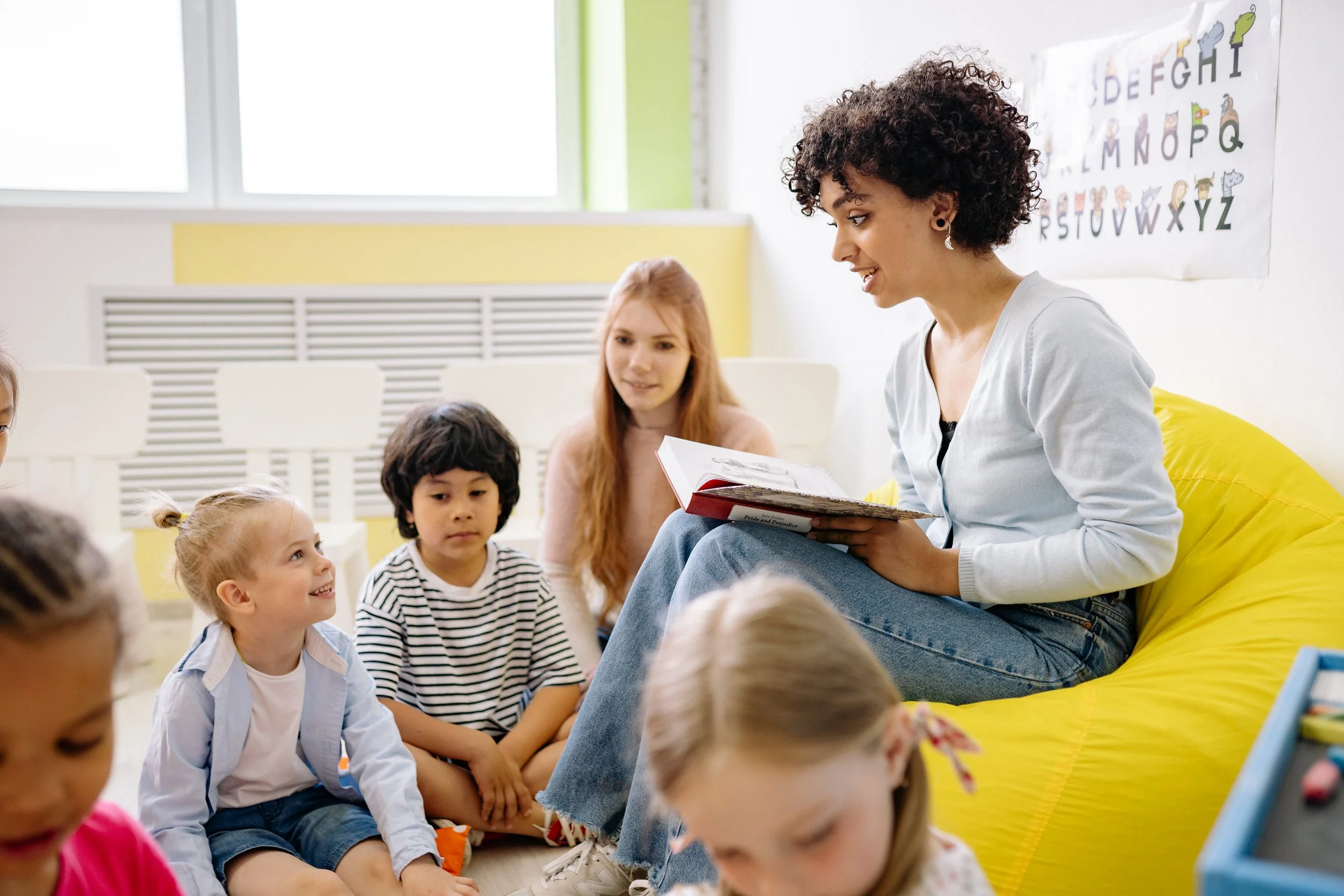A challenge that stands out to me from when I first started teaching is when I would patiently wait for my students to finish talking so I could read to them. We would all be sitting in a circle on the floor, criss-cross style, and I would have a book in my hands. Just as I would be able to hold up the cover for everyone to see, someone would start a conversation and just like a ball of yarn unraveling before my eyes, everyone would join in the chatter one-by-one. I had two options: the first was I could raise my voice to a level just above theirs to get their attention or second, I could sit and wait quietly until they realized I wasn’t going to start reading until the conversation had stopped. I liked choosing the second option because once I did have their attention I would explain that being a good listener meant giving whoever was speaking their full attention, otherwise they would miss the story! This took time but it helped my students to develop listening skills that would in turn help them develop their social awareness and build positive relationships.
Why do we need listening skills?
Auditory perception is our ability to interpret sounds, and listening allows us to truly process and understand information. For example, if I am sitting in a classroom where all the students are talking at the same time, I might hear all of them but I can only process, or truly listen to some of the information. Another example might be if I was sitting in a coffee shop and I can hear other people talking around me but I might be focused on my own task so I wouldn’t be able to tell you what the conversation next to me was about if you were to ask me.
Listening skills are what we need to have intentional conversations with others, to be aware of important information, and ultimately build strong relationships. Even as adults, this is a skill we continue to develop in our careers, especially if we are working in hybrid work environments. It is important for kids to develop this skill and to recognize what it looks like in practice.
How do we develop listening skills?
When we are asking kids to listen, an article from Teach Early Years shares, “We are actually asking them to take part in a complex process that at any point can be disrupted by factors such as the child’s stage of development, cognitive ability, state of mind or health.” In other words, as with any social emotional skill, developing listening skills won’t be linear but as educators and parents, we can incorporate regular listening skills activities to help kids with their development.
Additionally, we can be role models for kids on what it looks like to be actively listening. This can be demonstrated with verbal and nonverbal cues.
Nonverbal cues: It is important for your body language to be open. If you were to keep your arms crossed during a conversation or are looking away, this might appear that you are uninterested. Maintaining eye contact, nodding your head, and smiling are all positive ways to show others that you are engaged in the conversation. Remember that nonverbal cues may vary from country to country, and culture to culture.
Verbal cues: We don’t want to interrupt the person we are listening to and when it is our turn to speak we can ask follow up questions or provide affirmation that we understood what was said.
Activities for developing listening skills
Simon Says
This game helps kids develop their listening skills as they need to pay close attention to the instructions they are given. This can also be a great movement break game!
Designate one person as “Simon.” This person will be the leader and give instructions to the other people. The remaining people will be the followers who follow Simon’s instructions.
Simon, the leader, begins by saying "Simon says" followed by a simple instruction. For example, "Simon says, touch your nose."
The other people must quickly and accurately perform the action only if the instruction is followed by "Simon says." If Simon gives an instruction without saying "Simon says" and someone follows the instruction, that person is eliminated from the game for that round.
Continue giving instructions, alternating between those that begin with "Simon says" and those that do not.
The last remaining person is the winner of the round.
Popcorn Storytelling
Encourage kids to ignite their imagination as they work together to create a story!
Everyone sits or stands together in a circle.
One person starts the story and starts out with the words: “Once upon a time…”
Then they tell a few sentences of a story to get it going. It’s helpful for whoever is starting to establish a main character and a setting. Then they say, “Popcorn!” which means they’re ready to pass the story off to the next player. The story then pops over to the next person!
The next person picks up the story where it left off and the story continues until everyone around the circle had a turn or the story can continue around the circle again until the story is finished.
Guess the Sound
With either a group or partner, one person will make a sound in the room (turn on the sink, crumble a piece of paper, open and shut a book).
Everyone will need to keep their eyes closed while the sound is being made.
If you are playing as a group, you can award points to whoever guesses the sound first!
Conversation Starters
An important element of developing listening skills is to engage in conversation. In the classroom this can be formal: the teacher giving a lesson and giving students opportunities to ask questions. Or informal: students have a conversation about what kind of game they would like to play during free time.
You can use conversation starters such as the ones below to guide conversations. For each answer given to a question, have someone respond with a follow-up question. For example, if you ask “What is your favorite animal?” and the response is “My favorite animal is a dog”, your follow-up question could be, “What do you like most about dogs?” This shows the other person that you heard their response and are interested in learning more!
If you could have any animal as a pet, real or imaginary, what would it be?
If you could have a superpower for a day, what would it be?
What is your favorite thing to do on a rainy day?
If you could travel anywhere in the world, where would you go?
Meditations
Meditations, as a mindfulness activity, require the listener to be attentive and engaged. It requires the listener to be in the present moment, much like you would be if you were having a conversation with someone.
Guided meditations, such as those in Wisdom: The World of Emotions and My Meditations with Wisdom, give children an opportunity to practice their listening skills, reflect, and find deeper connection with their inner selves.
Our listening skills are instrumental in building positive relationships. These skills help us to have a strong social awareness and ultimately make more responsible decisions. Check out our Listening Skills Toolkit in our app, Wisdom: The World of Emotions (iOS, Android, Web) for more group activities, book suggestions, and movement activities!





